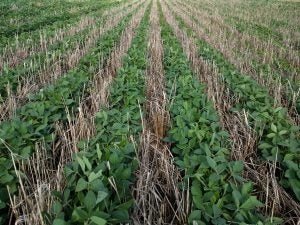A new national cover crop survey report released today shows that financial incentives play a major role in persuading farmers to adopt cover crops, but also that those ag producers who continue to use covers do so for many reasons beyond incentive programs.
According to the findings in the 2022-2023 National Cover Crop Survey, 49 percent of the cover crop users participating in the survey reported receiving some sort of payment for cover crops in 2022, and 77.8 percent of cover crop non-users said incentive payments would be helpful. However, 90.3 percent of the farmers who were receiving cover crop incentives reported that they would definitely or probably continue planting cover crops after the payments ended, while only 3.3 percent said they definitely or probably would drop cover crops at the end of the incentive program.
In all, just 15.6 percent of cover crop users said receiving incentive payments was one of their goals for cover cropping.
These findings were part of the report issued jointly by the USDA-NIFA Sustainable Agriculture Research and Education program, Conservation Technology Information Center, and the American Seed Trade Association.
Cover crops build healthy soil structure, reduce erosion and compaction, increase soil moisture and water filtration, sequester carbon, control weeds, and contribute to higher crop productivity, especially after three years. In general covers are widely believed to be a significant way to nurture the land’s agricultural legacy into the next generation.
“What the survey showed is that cover crop incentive payments are an important factor in encouraging and helping farmers to transition into cover cropping, but once they see the soil health improvements and other cover crop benefits, most stick with cover crop planting long after the incentives end,” said Rob Myers of SARE, lead researcher of the National Cover Crop Survey Report, which marked its seventh year. “Insights like these make the National Cover Crop Survey such a valuable tool in understanding the impacts of cover crops, the motivations of users and non-users, and needs for additional information and incentives.”
The data from this report has been used in academic research, educational programs, policy planning, and even testimony to Congress.
The 110-question survey was similar to that of past years but did include new sections on cover crop grazing, soil carbon programs, and managing cover crops before corn. It found that the average land in cover crops continued to rise, from 324.9 acres in 2018 to 413.6 acres in 2022. The bulk of the survey’s 795 respondents were from the north central United States, though almost every state had at least one respondent.

Ryan Heiniger, executive director of CTIC, noted during a video call reviewing the data from the survey that 80 percent of respondents were current cover crop users, 9 percent were past users, and 11 percent haven’t ever used cover crops. He also said that 97 percent of cover crop users have two years or more of experience with covers, while a whopping 39.5 percent have 10 years or more.
“This is a pretty fascinating and encouraging data set,” he noted.
It was also apparent that land ownership isn’t the barrier to cover crop adoption that many people thought it was, and that cover crops made the transition to no-till farm more likely for producers.
Additional insights
The report summarized data from the 795 farmers and divided them into user and non-user groups. Among the other findings in this year’s survey:
- Cover crops continued to show benefits for corn and soybean yields for experienced users of cover crop. The farmers with 10 or more years of cover crop experience had yield gains of 6.30 percent on soybeans and a similar 6.27 percent on corn.
- Farmers with two years or less of cover crop experience had modest soybean yield gains of 3.37 percent following cover crops; for those inexperienced cover crop users, average corn yields were not statistically different between cover crops and no cover crops.
- Improved soil health was a key goal for 95 percent of the cover crop users and a high-priority research item for 87 percent.
- Though 91 percent of cover crop users selected “add soil organic matter/sequestering carbon” as a key priority, just 16 percent of the users in the survey who received payments in 2022 reported participating in a carbon market program.
- 61 percent of the cover crop users reported planting green — seeding cash crops into a growing or just-terminated cover crop—somewhere on their operation.
- This was the first survey in the SARE/CTIC/ASTA series to explore livestock in cover crops. One in four respondents integrated livestock into their cover crop program. Of those who grazed cover crops, 76 percent reported a net increase in profit from the practice.
- In corn, 42 percent of cover croppers reported saving money on herbicides after cover crops, and 55 percent saw no change in herbicide expenditures. Among the “no change” group, 3 out of 4 observed better weed control in corn after cover crops.
- The seed supply chain is working effectively to scale with growing adoption. Only 7 percent of the cover crop users reported regular challenges in sourcing cover crop seed. Seed quality is important: 57 percent of cover crop users always look for a seed tag and 27 percent sometimes request them.
Andy LaVigne, president and CEO of ASTA, said, “Our members are extremely interested in learning about the needs of growers when it comes to which varieties they’re seeking and when and how they make cover crop planting decisions. These perspectives help the seed industry plan ahead to ensure that farmers have the species they want as well as genetics that help them manage their cover crops effectively to achieve their goals.”



